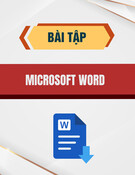Đặng Thanh Bình
Network File System
Contents
• How It Works • NFS Client Configuration • autofs • Common NFS Mount Options • Starting and Stopping NFS • NFS Server Configuration • Securing NFS • NFS and portmap • Using NFS over TCP
Introduction
• A Network File System (NFS) allows remote hosts file systems over a network and to mount interact with those file systems as though they are mounted locally.
• This enables system administrators to consolidate resources onto centralized servers on the network.
• This
chapter
focuses on fundamental NFS
concepts and supplemental information
HOW IT WORKS
How It Works
– NFS version 2 (NFSv2)
is older and is widely
supported.
– NFS version 3 (NFSv3) has more features, including 64bit file handles, Safe Async writes and more robust error handling.
– NFS version 4 (NFSv4) works through firewalls and on the Internet, no longer requires portmapper, supports ACLs, and utilizes stateful operations
• Three versions of NFS:
How It Works
• All versions of NFS can use Transmission Control Protocol (TCP) running over an IP network, with NFSv4 requiring it.
• NFSv2 and NFSv3 can use the User Datagram Protocol (UDP) running over an IP network to provide a stateless network.
• NFSv4 has no interaction with portmapper, rpc.mountd, rpc.lockd, and rpc.statd, since protocol support has been incorporated into the v4 protocol.
How It Works
• TCP is the default transport protocol for NFS
under Red Hat Enterprise Linux.
• UDP can be used for compatibility purposes as needed, but is not recommended for wide usage. • All the RPC/NFS daemon have a '-p' command line option that can set the port, making firewall configuration easier.
Working Procedure
• Firstly, the client is granted access by TCP
wrappers • Secondly,
server refers
its to the NFS configuration file, /etc/exports, to determine whether the client is allowed to access any of the exported file systems.
• Once access is granted, all file and directory
operations are available to the user.
Notes
• In order
for NFS to work with a default installation of Red Hat Enterprise Linux with a firewall enabled, IPTables with the default TCP port 2049 must be configured.
• The NFS initialization script and rpc.nfsd process now allow binding to any specified port during system start up.
Required Services
• nfs: NFS server • nfslock: a mandatory service that starts the appropriate RPC processes to allow NFS clients to lock files on the server
• portmap: accepts port reservations from local
RPC services
Required Services
• The following RPC processes facilitate NFS
services – rpc.mountd – rpc.nfsd – rpc.lockd – rpc.statd – rpc.rquotad – rpc.idmapd
NFS CLIENT CONFIGURATION
Mounting on the Client Side
• NFS shares are mounted on the client side using
the mount command -t
-o
mount
:
–
file system is to be mounted
Mounting on the Client Side
• Mounting remote file systems automatically at
boot time – Edit the /etc/fstab file – Use autofs service
Using /etc/fstab
• The general syntax for the line in /etc/fstab is as
follows:
server:/usr/local/pub /pub nfs rsize=8192,wsize=8192,timeo=14,intr – The mount point /pub must exist on the client
machine before this command can be executed.
– After adding this line to /etc/fstab on the client system, type the command mount /pub at a shell prompt
– The mount point /pub is mounted from the server
Using /etc/fstab
• The /etc/fstab file is referenced by the netfs
service at boot time
• Lines referencing NFS shares have the same effect as manually typing the mount command during the boot process.
• A sample /etc/fstab line to mount an NFS export
AUTOFS
autofs
• Kernel-based automount utility • Components of an automounter:
– A kernel module that implements a file system – A user-space daemon performing all other functions • autofs uses /etc/auto.master (master map) as its
default primary configuration file
• This can be changed to use another supported source and name using the autofs in
/etc/sysconfig/autofs)
(in
network configuration conjunction with Name Service Switch mechanism
autofs Configuration
• Configuration file: /etc/auto.master • Lists autofs-controlled mount points on the system, corresponding configuration files or
and their network sources known as automount maps.
• The format of the master map is as follows:
– mount-point is the autofs mount point e.g /home. – map-name is the name of a map source which contains a list of mount points, and the file system location from which those mount points should be mounted
autofs Configuration
• Map file structure:
[]
• Samples:
autofs
• Run autofs
• View the status of the automount daemon
COMMON NFS MOUNT OPTIONS
Mount Options
• fsid=num – Forces the file handle and file
attributes settings on the wire to be num
• hard or soft — Specifies whether the program using a file via an NFS connection should stop and wait (hard) for the server to come back online, if the host serving the exported file system is unavailable, or if it should report an error (soft)
• noacl — Turns off all ACL processing • nolock — Disables file locking
Mount Options
• nosuid — Disables set-user-identifier or set-
group-identifier bits
• noexec — Prevents execution of binaries on
mounted file systems
• tcp — Specifies for the NFS mount to use the
TCP protocol.
• udp — Specifies for the NFS mount to use the
UDP protocol
Mount Options
• Using soft mounts is not recommended as they in very congested
can generate I/O errors networks or when using a very busy server.
STARTING AND STOPPING NFS
Starting and Stopping NFS
• To run an NFS server, the portmap service must
be running.
• To verify that portmap is active, type
Starting and Stopping NFS
• /sbin/service nfs start • /sbin/service nfs stop • /sbin/service nfs restart • Only restart nfs if it is currently running – /sbin/service nfs condrestart
• Reload the NFS server configuration file without
restarting the service – /sbin/service nfs reload
NFS SERVER CONFIGURATION
Configuration File
• NFS configuration file: /etc/exports • Structure of a line for an exported file system:
()
()...
–
shared
–
Configuration File
– Single host
• Fully Qualified Domain Name, hostname, or IP address
– Wildcards: * or ?
• Should not be used with IP addresses; however, it is possible
for them to work accidentally if reverse DNS lookups fail
• Tend to be more exact than expected
– *.example.com as a wildcard allows sales.example.com to access
an exported file system, but not bob.sales.example.com
– *.example.com and *.*.example.com must be specified to allow
both
• Specifying host names:
Configuration File
– IP networks – netgroups — Permits an NIS netgroup name, written
as @
• Specifying host names:
Configuration File
• Sample of the simplest form of /etc/exports: /exported/directory bob.example.com • Cause no options specified, default options are
applied, including:

![Bài giảng Phần mềm mã nguồn mở [mới nhất]](https://cdn.tailieu.vn/images/document/thumbnail/2025/20250526/vihizuzen/135x160/6381748258082.jpg)


![Bài giảng Hệ điều hành: Trường Đại học Công nghệ Thông tin (UIT) [Mới nhất]](https://cdn.tailieu.vn/images/document/thumbnail/2025/20250515/hoatrongguong03/135x160/6631747304598.jpg)


![Bài giảng Hệ điều hành Lê Thị Nguyên An: Tổng hợp kiến thức [mới nhất]](https://cdn.tailieu.vn/images/document/thumbnail/2025/20250506/vinarutobi/135x160/8021746530027.jpg)












![Đề thi Excel: Tổng hợp [Năm] mới nhất, có đáp án, chuẩn nhất](https://cdn.tailieu.vn/images/document/thumbnail/2025/20251103/21139086@st.hcmuaf.edu.vn/135x160/61461762222060.jpg)


![Bài tập Tin học đại cương [kèm lời giải/ đáp án/ mới nhất]](https://cdn.tailieu.vn/images/document/thumbnail/2025/20251018/pobbniichan@gmail.com/135x160/16651760753844.jpg)
![Bài giảng Nhập môn Tin học và kỹ năng số [Mới nhất]](https://cdn.tailieu.vn/images/document/thumbnail/2025/20251003/thuhangvictory/135x160/33061759734261.jpg)
![Tài liệu ôn tập Lý thuyết và Thực hành môn Tin học [mới nhất/chuẩn nhất]](https://cdn.tailieu.vn/images/document/thumbnail/2025/20251001/kimphuong1001/135x160/49521759302088.jpg)
